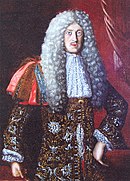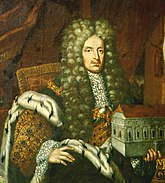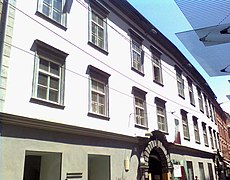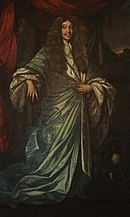Eggenberg (noble family)
Eggenberg is the name of an Austrian noble family of bourgeois origin, which - comparable to the Fuggers - rose to the nobility in the 16th century, to barons in 1598 and to high nobility in 1623 by being raised to princes ; the royal house of Eggenberg died out in the male line in 1717.
history
The origins of the zu Ekchenberg family lead to Radkersburg , where they got rich as middle-class wine merchants. In the course of the Counter-Reformation and re-Catholicization , they supported the Habsburgs , achieved the nobility and managed to become confidants of Emperor Ferdinand II as well as imperial princes and dukes of Krumau (in southern Bohemia) by granting loans in an astonishing ascent.
The first verifiable member of the family is Ulrich Eggenberger († 1448), merchant in Radkersburg, who was first mentioned in a document in 1432 in his function as Graz city judge, acquired residential property in and near Graz and with the bourgeois daughter Barbara Giebinger († 1451) was married. Under his two sons Hans and Balthasar († 1536), married to Sibylla Panichar († after 1553) in 1520, the family split into two lines. Hans founded the Radkersburger (later Ehrenhausen ) line and Balthasar the Graz main line of the Eggenberger.
Balthasar Eggenberger zu Eggenberg († 1536) received an impressive fortune after the death of his father Ulrich Eggenberger and continued the economically extremely profitable trading and coinage business. It was under him that the commercially successful connections with the Habsburg imperial court emerged. The emperor Friedrich III, who mostly resides in Graz . made Balthasar the mint master of Graz , Laibach and St. Veit an der Glan . This close connection to the imperial family and Balthasar's pronounced economic talent led to a considerable increase in Eggenberg's finances and possessions. The 15th century was marked by armed conflicts and threats from the Hungarian and Turkish invasions. During this time, Balthasar apparently changed sides at short notice as a financier. He was also named as head of the royal finance chamber of the Hungarian King Matthias Corvinus . Corvinus (Latin: raven-like) apparently also gave the new coat of arms of the still bourgeois Eggenberg family, which is already noble in its forms: three ravens wearing a crown. For this coat of arms, the award of which cannot be dated, there is another coat of arms legend in connection with an old gypsy woman and three ravens.
In 1463, Balthasar Eggenberger acquired an estate in the west of the then city of Graz as the family residence and had the fortified house expanded as the family's ancestral home, the initial building of today 's Eggenberg Palace . The Gothic Lady Chapel, mentioned in 1470, is now the oldest part of the palace complex, which was splendidly rebuilt in the Baroque style.
His son Christoph († 1520) received Augsburg citizenship in 1487 through marriage to a daughter of the mayor (town clerk) Leonhard Langenmantel von Radau and founded a branch of the family there. They built and lived in the so-called Imhofhaus here .
The Eggenberg family remained one of the most important patrician families in Styria until the 16th century . Christoph von Eggenberg († 1553) from the Radkersburg line of the family acquired Ehrenhausen Palace in 1543 . He and his son Ruprecht von Eggenberg expanded the castle because of the constant threat from the Turks and converted it into a renaissance castle. Ruprecht laid the foundations for the family's further rise through his military service as a general in the fight against the Ottoman Empire . This resulted in the elevation of the entire family to the Austrian baron class in 1598 .

This successful career of Ruprecht von Eggenberg was surpassed by the rise of his younger Graz cousin Hans Ulrich von Eggenberg (1568–1634). He is one of the most important statesmen in Styria. Like his cousin Ruprecht von Eggenberg, he became baron in 1598, imperial prince in 1623 , duke of Krumau in 1628 , after having been awarded the Golden Fleece in 1620 . In 1625 he became the imperial governor of Inner Austria . After a stay at the University of Tübingen and extensive trips to the Netherlands , Spain and Italy , Hans Ulrich returned to Graz after the death of his father. From 1564 to 1619 the city was the residence and capital of the inner Austrian Archduke . Hans Ulrich decided to enter the court service of Ferdinand II . In the following years, Hans Ulrich developed into one of the most important advisors and confidants at the Graz court. Ferdinand II von Habsburg became Emperor of the Holy Roman Empire of the German Nation in 1619 and moved the imperial court to Vienna . Hans Ulrich von Eggenberg moved with him and for two decades the son of a patrician family from Graz became one of the most important and influential men of the Holy Roman Empire and the leading diplomat of the Habsburgs during the Thirty Years' War (1618-1648). He remained loyal to the emperor as advisor, but returned to Graz as governor from Inner Austria in 1625 and ruled here “in place of the emperor” until his death in 1634. After the Battle of the White Mountain , Ferdinand II gave him the rule of Krumlov and Krumlov Castle in Bohemia in 1622 . He owned extensive lands that stretched from Krumau to Pettau / Ptuj and Gradiska on the Isonzo . At the zenith of his power in 1625, he gave the order to convert Eggenberg Castle (Graz) into a residence in keeping with his status, as the old family seat no longer met his requirements. He did not live to see the completion. Hans Ulrich Fürst von Eggenberg died in 1634. The representative building, which overshadowed everything else that existed in Styria at the time, was the family's residence until the male line of Eggenberg died out in 1717.

The only son of Hans Ulrich, Johann Anton I von Eggenberg , second prince of Eggenberg, Duke of Krumau (* 1610, † 1649) had an education at the Jesuit University in Graz, among others . After an extensive tour through Europe, he returned to Graz in 1632. At that time he campaigned for the further construction of the palace in Graz. His preferred residences, however, were the Eggenberg Palace on Sackstrasse in Graz and the residence in Krumau in southern Bohemia . He entered the imperial court service of Emperor Ferdinand III. An important goal for Prince Johann Anton I von Eggenberg was to obtain the full imperial status , which his father Hans Ulrich had hoped for in vain. In 1641 he obtained from the emperor the enfeoffment of the "prince-duchy Gradisca" , which was created from part of the prince-duchy of Gorizia for this purpose alone, with all sovereignty of an imperial fief, the regalia, the righteous and the income derived from it with the proviso of the relapse when the male line of the princely Eggenberg family died out. The emperor paid for this mortgage with the waiver of debts and cash payments. In addition to the city of the same name, the city of Aquileia and other localities also belonged to the ducal imperial county (since 1642) Gradisca . Thus, the Eggenberg were no longer just feudal takers of the Habsburgs in their hereditary lands Austria and Bohemia, as well as mere titular princes of the Holy Roman Empire, but directly ruling princes in a territory (the county of Gradisca) of the empire. This created the conditions for admission to a seat and vote on the Princely Bank of the Reichstag. But it was not until 1654 - after long resistance by the old princely houses in the Imperial Council of Princes against the social climbers - that the actual introduction took place.
After the Ehrenhausen line was extinguished in 1646, the market and Ehrenhausen Palace became the property of the Graz line. After the unexpectedly early death of Johann Anton I in 1649 and the lack of a legally valid last will, his two sons Johann Christian (1641–1710) and Johann Seyfried (1644–1713), oo I with Maria Eleonore von und zu Liechtenstein (1647-1704); oo II with Maria Josepha von Orsini-Rosenberg (1690–1715) because of the division of the paternal inheritance to differences. They initially agreed on an equal division of the properties. Johann Christian received the property with the over three hundred localities of the Duchy of Krumau in South Bohemia and Johann Seyfried decided on the inner Austrian possessions. The real dispute, however, flared up over Gorizia, because the seat in the Reichstag on the prince's bank was connected with it. It was not until 1672 that the contestants agreed on another inheritance contract. It remained with the division of the land. Johann Seyfried received increased capital, Johann Christian administered Gorizia (Gradisca) and received the right to vote in the Reichstag, albeit on behalf of both brothers.
Johann Seyfried Reichsfürst von Eggenberg placed his main focus on the development of the properties within Austria that were awarded to him and their income in order to cope with the costs of completing the Graz residence. During his reign, Eggenberg Palace received its first magnificent furnishings and the first remarkable gardens. Johann Seyfried was the host of the imperial bride of Emperor Leopold I before the marriage in 1673. Before this only wedding of an emperor, which took place in Graz, the future Empress Claudia Felicitas of Tyrol resided in the new family residence of the Eggenberg. Johann Seyfried von Eggenberg spared no expense in organizing the imperial visit. His brother Johann Christian knew how to increase the income from his properties and keep them together. Johann Seyfried almost completely ruined himself financially with his lifestyle. Only the sale of possessions and the close ties to the imperial house of the Habsburgs could save him again and again.
After the death of Johann Christian I († 1710), who had no heirs, his widow Marie Ernestine Countess zu Schwarzenberg inherited the Bohemian dominions of Krumau and Nettolitz . She died in 1719. Since at this time the Eggenberg family had also expired in the male line of the Graz line, she appointed her nephew Adam Franz Karl zu Schwarzenberg as a universal heir. The Krumlov rule remained in the possession of the Schwarzenbergs until the expropriation in 1945 .
After Johann Seyfried's death in 1713, his line had male descendants for two generations. The daughters had been married in the meantime when the only son Johann Anton II von Eggenberg (1669-1716) died in 1716 at the age of 47, since 1691 married to Maria Karoline Countess von Sternberg († 1754). A year later, their only son, Johann Christian II von Eggenberg, died of appendicitis at the age of 13. With his death in 1717, the Eggenberg family died out in the male line. In the period that followed, the extensive Eggenberg estates were divided up by inheritance contracts.
One of the two sisters of Johann Christian II, Maria Eleonore Reichsfürstin zu Eggenberg (1694–1774), first marriage 1719 to Josef Patrik Graf Leslie (1694–1732), second marriage 1733 to Andreas Siegmund Graf von Welz and third marriage 1740 with Johann Leopold Graf Herberstein (1712–1789), died childless in 1774, so her third husband became her universal heir. Their property with the Eggenberg Palace and the Eggenberg City Palace in Graz, now Palais Herberstein , came to a branch of the Herberstein family , who owned both houses until 1939.
- Residences of those from Eggenberg
Český Krumlov Castle (Bohemian Krumlov)
Gradiska Castle on the Isonzo
Palais Eggenberg , from 1774 Palais Herberstein, Graz
coat of arms
Blazon: In silver in the middle a golden helmet crown , accompanied in the shape of a three pass , each with the head to the crown, by three golden crowned, black armored and red-tongued ravens , in the posture of a normal heraldic eagle . On the crowned helmet with black-and-silver covers a gold-crowned, black-armored and red-tongued raven, ready to fly in the stance of a cortezoid .
Heraldic saga
“The new castle, which has as many windows as there are days in the year, is located near the old castle of the Eggenberg family.” The coat of arms of the Lords of Eggenberg shows a princely crown carried by three ravens with their bills.
The lord of the castle of Eggenberg had been out of the house for a long time during the war against the Hungarians. Meanwhile, his wife was begging for a walk by an old ragged gypsy woman. The gypsy cheekily demanded a gift, which angered the castle lady and therefore she gave her nothing. Thereupon the gypsy shouted: “Just wait, just wait, you'll still think of me!” After a few years the lady of the castle gave birth to a boy. A gang of gypsies once came into the castle courtyard and played funny songs. The lady of the castle was not at home and the whole thing Servants danced happily with the gypsies. Only the nanny stayed with the child. But she, too, was brought to the dance. When she returned, however, the boy had disappeared from the cradle. The old gypsy had stolen the boys secretly. They were with the boy too Gypsies from the castle. A boy who was on his way to Thal noticed that three ravens were circling a certain place. The boy went there and found a small child wrapped in diapers. He took it and went on to Thal. Then met he the weeping nanny who recognized the boy immediately and brought him back to the castle. The boy who had found the child was richly rewarded. After the master of the castle left the war When he returned, he included the three ravens in the Eggenberg coat of arms in memory of this terrible event. "
Important Eggenbergers

- Christoph von Eggenberg († 1553 )
- Helena von Eggenberg († before 1568 ), née Fueger
- Hans Christoph von Eggenberg († 1581 )
- Maria von Eggenberg, née Galler von Schwanberg
- Bartholomäus von Eggenberg († 1583 )
- Justina von Eggenberg, née von Breuner
- Ruprecht von Eggenberg (* 1546 † 1611 ), Austrian general, 1598 baron ; buried in the Ehrenhausen mausoleum
- Wolff von Eggenberg († 1615 ), Colonel General, buried in the Ehrenhausen mausoleum
- Maria Franziska Princess von Eggenberg, married to Leonhard VII. Count von Harrach († 1645), Imperial Colonel-Court Marshal, ancestors of the now extinct house of Rohrau of the Counts of Harrach
- Johann Anton I von Eggenberg (* 1610; † 1649), 2nd Prince of Eggenberg and 2nd Duke of Krumau in South Bohemia (1634–1649)
- Maria Elisabeth Countess of Eggenberg (born September 25, 1640 - May 19, 1719), daughter of Johann Anton 2nd Prince of Eggenberg, Duke of Krumau in South Bohemia and Anna Maria, née Margravine of Brandenburg-Bayreuth (1609–1680) ; 1656 married to Ferdinand Joseph 3rd Imperial Prince of Dietrichstein zu Nikolsburg (succ. 1655), (1636–1698), on Budin an der Eger, Libochowitz, Nepomyssl and Wällisch-Birken in Bohemia.
- Johann Christian von Eggenberg (around 1680 )
- Princess Maria Charlotte von Eggenberg († 1755 )
- Princess Maria Eleonore Anna Josepha von Eggenberg (1694–1774), oo I 1719 Josef Patrik Graf Leslie (1694–1732); oo II 1733 Count Andreas Siegmund von Welz; oo III 1740 Johann Leopold Franz Graf von Herberstein (1712–1789)
- Princess Maria Theresia Josefa von Eggenberg (1696–1762), married to Karl Kajetan Graf Leslie (1696–1762) in 1719 , after 1735 owner of the Ehrenhausen estate in Styria
Prince of Eggenberg
- Johann Ulrich von Eggenberg (* 1568; † 1634) 1598 Baron, 1623 1st Prince of Eggenberg, 1628 Duke of Krumau; ⚭ Freiin Maria Sidonia von Thannhausen, daughter of Baron Konrad von Thannhausen and Dorothea von Teuffenbach.
Son:
- Johann Anton I von Eggenberg (* 1610; † 1649), 2nd Imperial Prince of Eggenberg, Duke of Krumau (1634–1649), Prince Count of Gradisca in 1647; ⚭ Margravine Anna Maria von Brandenburg-Bayreuth , daughter of Margrave Christian von Brandenburg-Bayreuth
Son:
- Johann Christian I. von Eggenberg (* 1641; † 1710) 3rd Prince of Eggenberg, Duke of Krumau (1649–1710) ⚭ Princess Maria Ernestine zu Schwarzenberg (Franconian-Bohemian noble family) . Through this marriage, the rule of Krumlov in South Bohemia came into the possession of the nephew Adam Franz Fürst zu Schwarzenberg , to whom Emperor Charles VI of Habsburg in 1723 conferred the hereditary title of duke after the extinction of the male Prince Eggenberg deszendenz in Graz . Maria Ernestine von Eggenberg, née Countess von Schwarzenberg, died in 1719 without descendants and was the daughter of Johann Adolf I, Prince of Schwarzenberg.
Brothers:
- Johann Seyfried von Eggenberg (* 1644; † 1713), 4th Prince of Eggenberg, Duke of Krumau etc. (1710–1713), ⚭ 1.) 4./11. July 1666 Princess Maria Eleonora von und zu Liechtenstein (* 1647; † 1704),
Son:
- Johann Anton II. Josef (* 1669; † 1716), 5th Imperial Prince of Eggenberg, Duke of Krumau etc. (1713–1716) ⚭ Countess Maria Karolina von Sternberg (ze Šternberka), daughter of Oldřich Adolf Vratislav, Count von Sternberg 1661,
Son:
- Johann Christian II of Eggenberg (* 1704; † 1717), 6th Prince of Eggenberg, Duke of Krumau etc. (1716–1717). His father's only son. With him the house of the Princes of Eggenberg went out in the male line.
literature
- Franz von Krones: Eggenberg . In: Allgemeine Deutsche Biographie (ADB). Volume 5, Duncker & Humblot, Leipzig 1877, p. 662.
- Barbara Kaiser: Eggenberg Palace. Christian Brandstätter Verlag, Graz 2006, ISBN 3-902510-96-X (English Edition, ISBN 3-902510-80-3 )
- The Emperor's uncle and very dear Prince - Eggenberg Palace, Graz . In: From castle to castle in Austria . With aerial photographs by Lothar Beckel. Verlag Kremayer & Scheriau, Vienna 1976, ISBN 3-218-00288-5 , pp. 102 and 103.
- Hans von Zwiedineck-Südhorst: Hans Ulrich Fürst von Eggenberg: friend and first minister of Emperor Ferdinand II. BiblioBazaar, Charleston SC 2009. (new edition of digitally preserved original German text printed in Vienna in 1880, printed in Leipzig by Amazon Distribution) ISBN 1 -113-02782-7
- Franz Kammerhofer: A state in old Austria: possessions of the Eggenberger . Franz Kammerhofer, Graz 1998, ISBN 3-9500808-1-3
- Walther Ernest Heydendorff: The princes and barons of Eggenberg and their ancestors . Styria Publishing House, Graz 1965.
- Barbara Kaiser: Eggenberg Castle: Learning aids for guides . Landesmuseum Joanneum, Graz 2001.
- Gerhard Bernd Marauschek: Inaugural dissertation. The princes of Eggenberg. Graz 1968. (dissertation available at the university library of Karl-Franzens University in Graz)
- Franz Karl Wißgrill : Scene of the rural Lower Austrian nobility ... Volume 2. (1795), p. 354 ff.
- Jan Županič, František Stellner, Michal Fiala: Encyklopedie knížecích rodů zemí Koruny české . Aleš Skřivan ml., Praha 2001, ISBN 80-86493-00-8 , 340 pp.
- I Principi di Eggenberg sovrani di Gradisca 1647-1717 (Comune di Gradisca d'Isonzo - Assessorato alla Cultura)
- M. Masau Dan: Fortezza di Gradisca (Consorzio per la salvaguardia dei castelli storici del Friuli-Venezia Giulia)
Web links
Individual evidence
- ↑ The Eggenberger in the Augsburger Stadtlexikon ( Memento of the original from January 24, 2018 in the Internet Archive ) Info: The archive link has been inserted automatically and has not yet been checked. Please check the original and archive link according to the instructions and then remove this notice.
- ↑ Johann Schleich (Ed.): The Styrian Sagenschatz . Graz 1999, p. 389









